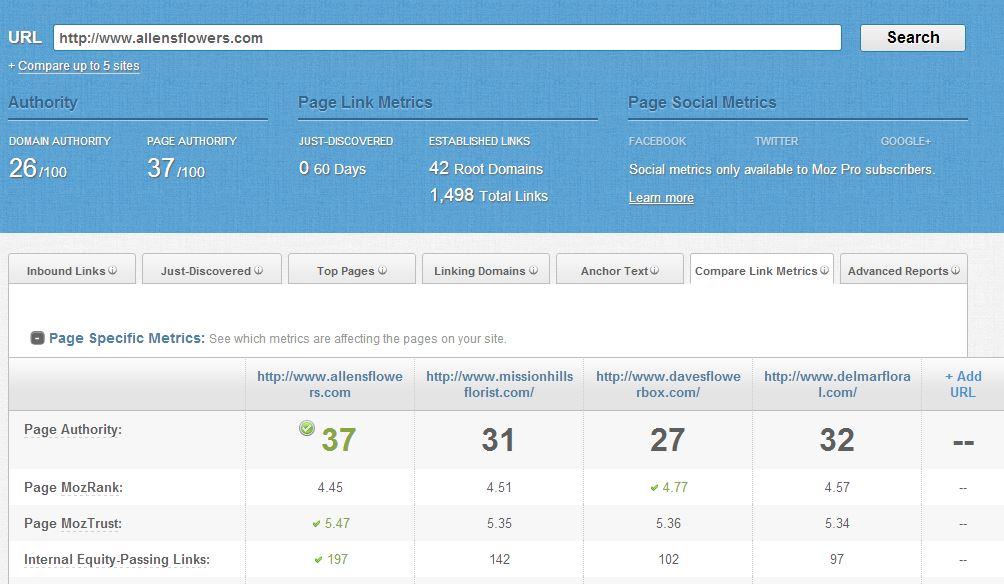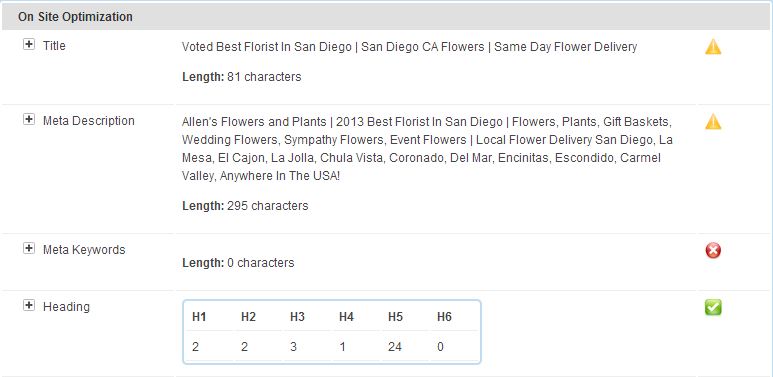 Have you ever looked at a competitor’s website and wondered why they were ranking higher than you in search engines?
Have you ever looked at a competitor’s website and wondered why they were ranking higher than you in search engines?
In this post, we’re going to walk through the process of completing a search engine optimization (SEO) analysis, a tool to help you better understand the competitive landscape of search engine rankings in your industry.
This SEO competitive analysis will provide a base of knowledge and a strategic foundation you can use to outrank your competitors in Google and other search engines.
Creating a List of Relevant Keywords
The first step to any effective SEO initiative is knowing what keywords you want people to search in order to find your business.
For example, if I owned a San Diego flower delivery service, I might use these variations of a keyword:
- San Diego flower delivery
- Who delivers flowers in San Diego
- Flower delivery San Diego
A keyword list is what I like to call the “keyword portfolio.” — an organized file with the relevant keywords that you would like to rank for in search engines, where you currently rank for these keywords, and where your competitors currently rank for these keywords.
Your keyword portfolio will be an evolving list of keywords that you’ll constantly be adding to and subtracting from as your strategy changes.
If you don’t have a keyword portfolio already, you can easily create one with a simple Excel spreadsheet using the following three columns from left to right:
- Targeted Keyword
- Overall Position in Search Engine
- Found by searching for the targeted keyword and making note of your website’s position in the results (1-10)
- Description of Competitor Rankings
- Where are your main competitors ranking for the searched keyword?
As you go through the process of setting up this spreadsheet, you’ll likely come across other keywords your competitors’ are using, which should be added to your keyword portfolio.
Link Analysis with Moz Open Site Explorer
Apart from strong use of relevant keywords, the number of links to you
In the next part of your competitive analysis, I recommend using the Moz Open Site Explorer to see the types of links your competitors have.
Doing so will answer three very important questions for you:
- How many links do my competitors have?
- Are there links my competitors have that I don’t, but that I can get?
- Which of my competitors is most skilled at getting links?
In order to get started using the Open Site Explorer, let’s assume that we operate Allen’s Flowers, a floral shop located in San Diego, California.
First, type the website into the search bar:
Make sure you’ve clicked “Compare up to 5 sites” under the search bar.
Next, type in a few of your competitors (I’ll be using several other San Diego Floral shops):
Once you click “Compare” you’ll be taken to the results of the comparison:
The default results will have the “Compare Link Metrics” tab kept open. Here’s why this tab is important to you:
- Total Links: This shows the total number of links pointing to your site, including internal links (links between your own web pages), and external links (links from other websites)
- Total External Links: This is the total number of links from other websites. There are usually many links that appear repeatedly.
- Followed Linking Root Domains: This will be your most important statistic. This section shows you how many unique websites (“linking root domains”) have links that Google counts (Google ignores “nofollow” links) for your site.
There are many other results and statistics listed on this page, but these are the most important ones to help with your SEO competitive analysis.
In order to get a more detailed look at what the links pointing at these sites look like, click on the “Inbound Links” tab.
Then, we can filter out some of the results to figure out which links are actually helping your site and the sites of your competitors.
Click on the filters to change them to say:
Show “ONLY FOLLOW” links from “ONLY EXTERNAL” pages to “PAGES ON THIS SUBDOMAIN” and “SHOW LINKS UNGROUPED”.
Now, click “Filter” to get your results.
Once you’ve gotten your results, ask yourself the following questions about the links:
- Does the anchor text match my keyword? The displayed text of a link is known as “anchor text”.
- Does the link come from a page with high authority? A link on a high page authority would be worth a lot more than a link on a low page authority (e.g. MSNBC.com would have more page authority than a local news site)
- Does the link come from a domain with high authority? This is similar to the previous question, but Google looks first at the page authority (popularity of a single page), before checking domain authority.
This exercise is intended to help you comb through your competitors’ link portfolios to see if there are any patterns you can detect.
Try to get as much information as you possibly can off of these reports. Remember, link portfolios are not the entire picture, but a large part of that picture.
The other factor that is a big part of where you’re ranked on Google is on-page SEO. If you have a website with many links and Google-friendly on-page SEO, you’ll climb to the top.
The next tool I’m going to introduce you to for help with on-page SEO is SEOToolsCentral.
Monitoring Competitors’ On-page SEO
SEOToolsCentral is one of the best tools to go in-depth with your SEO competitive analysis.
SEOToolsCentral is a website review tool that shows you a ton of on-page SEO factors which contribute to Google’s ranking of your website. Once it analyzes a site, it will create a report that gives you valuable information about that site including:
- Traffic
- Social Media
- SEO Details (meta description, header tags, keywords, etc.)
- Server Hosting Information
Once your report is generated, the first section you’ll see is the “On Site Optimization” information. SEOToolsCentral gives you helpful information about various on-page SEO factors in this report. If there’s information you don’t understand, check out Moz’s SEO Glossary for simple explanations.
Remember, SEOToolsCentral is a guide for you to identify issues with your website and opportunities your competitors aren’t taking advantage of.
Identifying Your Top Competitors
Once you’ve gathered all the data from your keyword spreadsheet, Open Site Explorer, and SEOToolsCentral, the next step is to take that information and determine who exactly your top competitors are.
Any site you’ve seen pop up consistently in Google’s rankings is one you can probably consider as a “Top Competitor”. Figuring out the next two or three top competitors might be a little trickier though.
I like to keep four specific criteria in mind when determining who my top competitors are. For instance:
- Lots of Links: again, Google’s main attribute for SEO is links. If a site has a ton of links, this is most likely a site to keep your eye on.
- Ranking at the Top of Google: any site that consistently ranks at the top of Google for your target keywords is very likely a direct competitor.
- Lots of On-page SEO: using SEOToolsCentral, you can easily see if a site has invested time into their on-page SEO.
- Many “Following” Linking Root Domains: this signals a site is your direct competitor, because they have many different links from many different places.
How To Beat the Competition
The most important step to beating your competitors is gathering as much information you can through your keyword portfolio, Open Site Explorer, and SEOToolsCentral.
Once you discover the reasons for your competitors’ high rankings, you’ll have a solid view of what you need to do to overtake them.
Here are the next steps you can take after finishing your SEO competitive analysis:
- Updating your list of “Top Competitors” depending on the most recent rankings on Google
- Adding to and updating your “Keywords Portfolio” based on your competitors’ pages
- Adding new pages to your site based on promising new keywords you find so that Google can rank you for that keyword
- Determining what your competitors are doing in terms of both a) link building and b) on-page SEO, so that you can strategize to overtake them
Remember, a competitive analysis is important mostly for giving you a baseline about your place in the competitive landscape.
You’ll have to revisit your SEO competitive analysis often in order to maintain your knowledge of Google’s rankings. Going through this process regularly — once every couple months or so — will allow you to become an expert player and take the knowledge gained to increase your website’s ranking.
_______________________________
About the Author: Matt Carter is an Internet Marketer based in San Diego, CA. You can read his marketing blog at MGX Mindshare.








Speak Your Mind